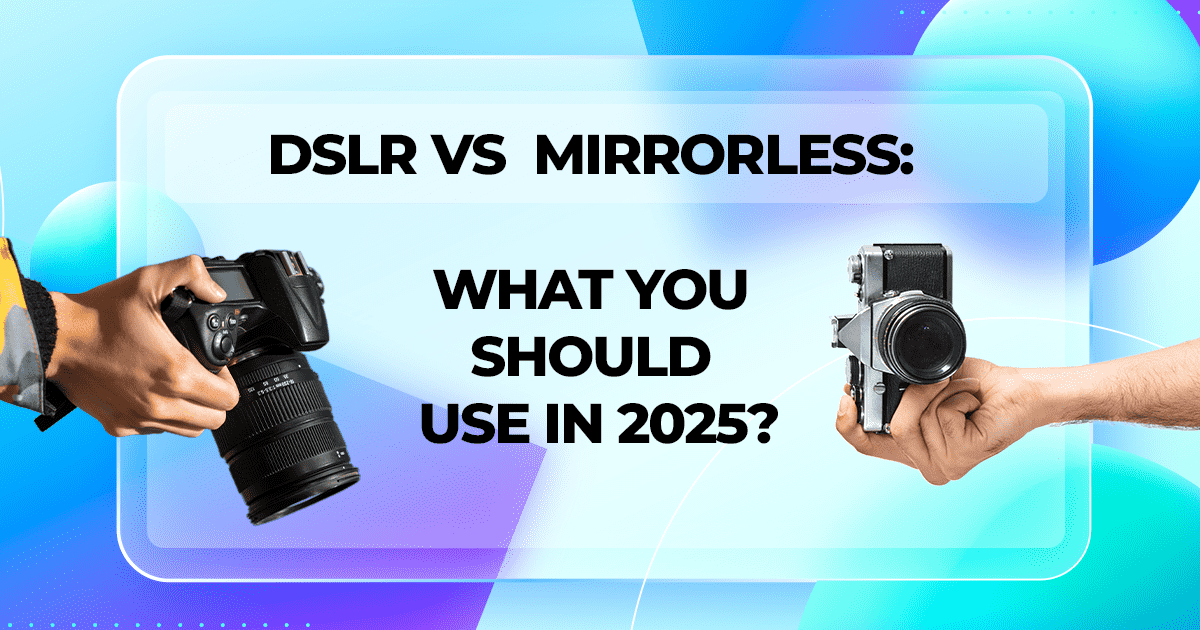DSLR vs Mirrorless: What You Should Use in 2025?

DSLR vs Mirrorless: What You Should Use in 2025?
Cameras are one of the most important gadgets to capture life’s moments but choosing the right one is also a great task especially with the increased options in the market. One of the biggest decisions you'll face is choosing between a DSLR and a mirrorless camera. Both are excellent, but which one's better for you?
Both the cameras produce stunning photos, but they function differently and serve a different purpose as well. Nevertheless, if you're capturing family memories, operating a business, or editing images, let's simplify the differences to assist you in choosing the camera that is your perfect fit.
What's the Difference?
To make things easier, let’s start with the DSLR, which is the most commonly preferred option for a camera. A DSLR (Digital Single-Lens Reflex) camera has a mirror within to reflect light from the lens to an optical viewfinder. When you press the shutter, the mirror comes up, allowing light to strike the sensor.
That's why DSLRs have a traditional "click" sound. Mirrorless cameras dispense with the mirror altogether. Light passes directly to the sensor, and you get a digital preview on an electronic viewfinder (EVF) or the rear screen.
Why Use a DSLR?
DSLRs have been around forever, and they're still a favorite for reasons known to every teenager and camera fanatics. Here are a few reasons you may choose one:
Long Battery Life: DSLRs are champs at lasting all day. For example, a Canon EOS Rebel SL3 can snap over 1,000 shots on a single charge, while many mirrorless cameras tap out around 400-500 shots. Perfect if you’re shooting a wedding or hiking without a charger.
Budget-Friendly Options: DSLRs tend to cost less, particularly second-hand. With Canon and Nikon concentrating on mirrorless, you can pick up a quality DSLR, such as the Nikon D850, at a discount. This gives you more money to spend on lenses or editing.
Tons of Lenses: DSLRs have been around for eons, so you have a massive selection of lenses to choose from. Whether you're shooting landscapes or portraits, there's low-cost, high-quality glass that's been tried for years.
Comfortable Grip: DSLRs are larger, which can be a good thing. If you've got bigger hands or shoot with heavy lenses, their chunky body feels solid and balanced.
But DSLRs aren't without their flaws. Their large size can also be a hassle for travel. Their autofocus, although good, isn't quite as snappy on subjects that move really fast, such as pets or sports.
On top of that, since most of the companies are going mirrorless, new DSLR releases are scarce in 2025.
Why Go Mirrorless?
Mirrorless cameras are the newcomers to the block, and they're taking center stage in 2025. Here's why they could be your choice:
Light and Convenient: Omitting the mirror, mirrorless cameras are both lighter and more compact. Take a Canon EOS R8 with a lens compared to the same DSLR setup weighing around 34% less. This makes them fantastic for travel or extended shoots when you don't have time for a tired back.
Super-Fast Autofocus: Mirrorless cameras excel with AI-driven autofocus that can lock onto eyes, animals, or even particular faces (such as on the Canon EOS R1). A revolution in capturing kids playing or wildlife in motion.
Real-Time Previews: The electronic viewfinder displays precisely what your photo is going to look like—lighting, color, and all—before you take the shot. That translates to fewer surprises and less time adjusting after the fact with software available online.
Video Powerhouse: For vloggers or filmmakers, mirrorless cameras set the pace. They provide 4K, 6K, or 8K video capabilities, and advanced features such as log profiles to enable pro-level editing. DSLRs find it difficult to match here.
Conversely, mirrorless cameras drain batteries more quickly due to that continuously activated digital viewfinder. Their lenses may be more expensive, too, although adapters enable you to employ DSLR lenses if you're transitioning.
Moreover, certain photographers have been known to miss the "real" experience of a DSLR optical viewfinder.
What's Happening in 2025?
The world of photography is going all-in on mirrorless. Large manufacturers like Canon, Nikon, and Sony are throwing their top technology into mirrorless models, with advancements such as improved stabilization and more intelligent autofocus.
DSLR manufacturing is winding down—Canon and Nikon haven't introduced new DSLRs since 2020, and even their lenses are moving to mirrorless mounts.
But DSLRs aren't dead yet! They're still a wonderful option for photographers who need to save money or want to stick with their trusty equipment.
Which Do You Choose?
Depends on what you're capturing and how you shoot:
Select a DSLR if: You have a limited budget, require lengthy battery life, or already have DSLR lenses. They're perfect for newbies or pros who enjoy the traditional feel and don't require the newest tech.
Select a Mirrorless if: You desire an ultra-lightweight camera, capture fast motion or video, or enjoy previewing your shot's final appearance before you take it. Mirrorless is the future, so you'll enjoy leading-edge features and compatibility for years to come.
Conclusion
Both DSLRs and mirrorless cameras can assist you in capturing great moments in 2025. DSLRs are value and reliable, and mirrorless cameras are portable and state-of-the-art.
Consider your style—casual snaps, pro shoots, or vlogging—and pick what comes naturally.
Regardless of the camera you choose, when it comes to sharing your photos with others, look no further than Foto Owl, which lets you use AI-powered face recognition and automatic smart tagging to organize, find, and share your images. Whether you’re an amateur or a pro, your photography deserves more than a cluttered folder.
So shoot smart and share smarter with Foto Owl!